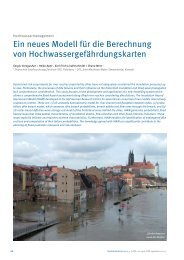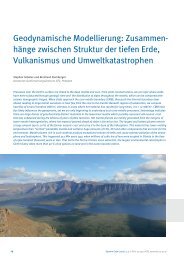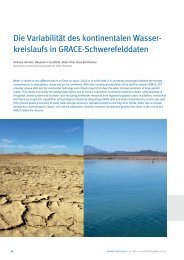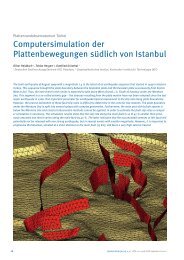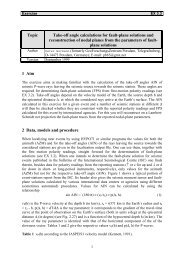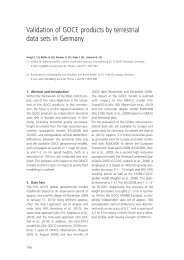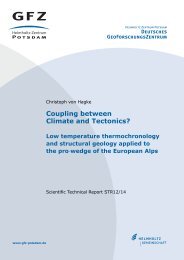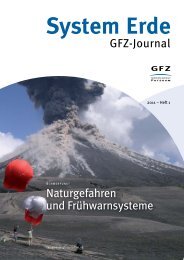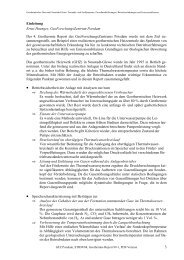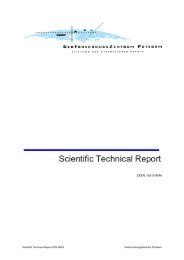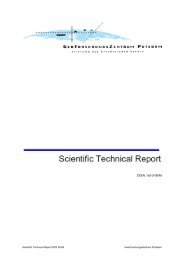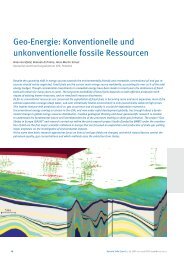2 Seismic Wave Propagation and Earth models
2 Seismic Wave Propagation and Earth models
2 Seismic Wave Propagation and Earth models
You also want an ePaper? Increase the reach of your titles
YUMPU automatically turns print PDFs into web optimized ePapers that Google loves.
2. <strong>Seismic</strong> <strong>Wave</strong> <strong>Propagation</strong> <strong>and</strong> <strong>Earth</strong> <strong>models</strong><br />
In the case of deep earthquakes the direct P wave that leaves the source downward will arrive<br />
at a teleseismic station first. It will be followed, depending on the source depth, up to about<br />
4.5 min later by other phases that has left the source upward. These phases, reflected <strong>and</strong><br />
eventually converted at the free surface of the <strong>Earth</strong> or an ocean bottom (e.g., pP, sP, pPP,<br />
sPP, pPKP, etc.), at the free surface of the ocean (e.g., pwP) or from the inner side of the<br />
Moho (e.g., pmP) are the so-called depth phases. Their proper identification, onset-time<br />
picking <strong>and</strong> reporting is of crucial importance for reliable determination of source depth (see<br />
6.1 <strong>and</strong> Figure 7 in Information Sheet 11.1). Differential travel-time tables pP-P <strong>and</strong> sP-P are<br />
given in the Exercise EX 11.2. For the definition of these phases see also IS 2.1.<br />
Fig. 2.43 Left: Different ray paths of a direct teleseismic P wave <strong>and</strong> of its depth phases.<br />
Right: Records of depth phases of the May 24, 1991 Peru earthquake (hypocentral depth h =<br />
127 km); a) broadb<strong>and</strong> record <strong>and</strong> b) simulated short-period recording (the right figure is a<br />
corrected cutout of Fig. 6.4 of Lay <strong>and</strong> Wallace, Modern Global Seismology, p. 205, © 1995;<br />
with permission of Elsevier Science (USA).<br />
However, the identification of depth phases is rather difficult for shallow crustal earthquakes<br />
because their onsets follow rather close to the direct phase, thus superposing with their<br />
wavelets. They may, however, be discriminated by waveform modeling with variable source<br />
depth (see subchapter 2.8, Fig. 2. 56).<br />
Between about 30° <strong>and</strong> 100° epicentral distance P <strong>and</strong> S have traveled through the lower<br />
mantle, which is characterized by a rather smooth positive velocity <strong>and</strong> density gradient (see<br />
Fig. 2.53). In this distance range, seismograms are relatively clearly structured with P <strong>and</strong> S<br />
(or beyond 80° with SKS) being the first, prominent longitudinal <strong>and</strong> transverse wave<br />
arrivals, respectively, followed by multiple surface <strong>and</strong> core-mantle boundary (CMB)<br />
reflections or conversions of P <strong>and</strong> S such as PP, PS, SS <strong>and</strong> PcP, ScP etc. (see Fig. 2.42 <strong>and</strong><br />
2.48 with overlay). Within about 15 to 35 min after the first P arrival multiple reflections of<br />
PKP from the inner side of the CMB (PKKP; P3KP) or from the surface (PKPPKP = P'P')<br />
may be recognizable in short-period seismic records. Their ray traces are shown in Fig. 2.44<br />
<strong>and</strong> many more, with record examples, in 11.5.3.<br />
48



